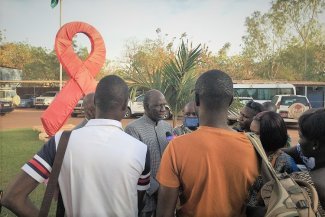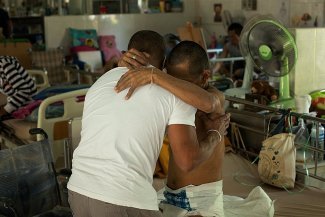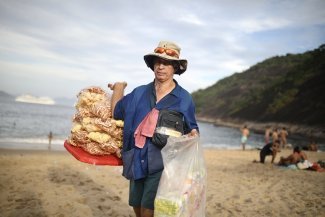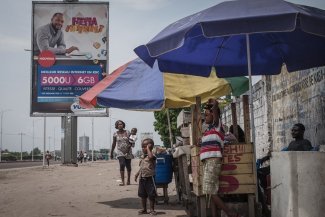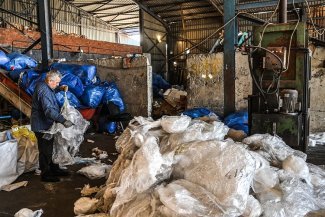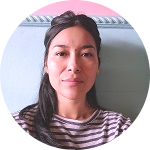
A machine operator places a giant condom on the obelisk in Sete de Setembro Square in Belo Horizonte, Brazil on World AIDS Day on 1 December 2022. The message of this direct action (carried out by the Association of Prostitutes of Minas Gerais) is that condoms help prevent sexually transmitted diseases.
“I was diagnosed with HIV six years ago and it was a very tough time for me emotionally. It was very challenging, and I spent about a year and a half with serious depression, going through very difficult moments emotionally,” says Juan De La Mar, a Colombian filmmaker and director of the documentary De Gris A POSITHIVO (From Grey to POSTIHIVE), a work in which he captures his own experience with HIV, using art as therapy and a tool to challenge and unravel deep-rooted stereotypes.
“I felt I was in limbo, that I was too afraid of dying, that I wasn’t doing much, that I was stagnating, and I wasn’t able to shake off this sense of fear, guilt and unease. Then, because I had seen how art had changed other people’s lives, I wanted to do the same for myself,” he recalls.
The impact of the documentary led the filmmaker to develop a deeper understanding of the magnitude of the HIV situation in his native Colombia and beyond. And while medical developments have significantly improved quality of life for people living with HIV, the documentary illustrates how little it is talked about in society.
In Latin America and the Caribbean, despite efforts by several countries to address the challenges posed by the virus, infection rates remain high and, in recent years, the disruption of health services due to the Covid-19 pandemic also increased the vulnerability of people with conditions such as HIV or AIDS and impacted their access to care.
According to the UNAIDS report The Path that Ends AIDS, which compiles the latest global data on HIV/AIDS, at least 2.2 million people are living with HIV in the region, and while the number of people dying of AIDS since 2010 has fallen by 32 per cent to 27,000 (in 2022), the number of new infections rose by eight per cent during the same period.
For Luisa Cabal, regional director of UNAIDS for Latin America and the Caribbean, the HIV issue remains intrinsically linked to the level of political will and investment in prevention by governments, which, she says, is fundamental and should be prioritised, taking on board the needs and particularities of each nation.
“The figures are definitely not as encouraging as we had hoped this year [...]. We have taken our eye off the ball and we need to act fast and step up the prevention mechanisms that we know work; the evidence and the science are on our side, but what we need is greater political will,” says Cabal, underlining the progress made in recent decades, especially in the scaling up of antiretroviral treatment, which has had a major impact on reducing AIDS-related mortality.
A holistic approach?
Since 1985, when the first HIV test was introduced and the modes of HIV transmission (sexual, blood and perinatal) were identified, the scientific community has made significant progress in the management and control of the virus.
Today, the main treatment is a single daily pill known as antiretroviral therapy, with minimal side effects. In terms of prevention, in addition to the use of condoms, pre-exposure prophylaxis (PrEP) has emerged as a highly effective alternative. According to UNAIDS, there has been an increase of over 55 per cent, since 2021, in the number of people choosing this option in the region.
In this regard, Cabal stresses the need for greater government investment in PrEP to ensure that it is accessible to higher-risk groups, such as gay men, other men who have sex with men (MSM) and transgender people, as well as sexually active people in general.
She also underlines the importance of keeping a close watch on the accessibility of conventional prevention methods, such as condom use.
“We need a more holistic approach to this issue, taking on board dimensions such as gender, class, identity or ethnicity, to ensure the inclusion of all people in the policies implemented,” says the UNAIDS regional director.
Cabal gives a clear illustration of the urgent need for more inclusive policies in the region, pointing out that while governments are working to curb the spread of HIV among the groups prioritised, infection rates among other groups, such as women, are rising, as is the number of children born with HIV.
Similarly, a recent study in The Lancet Regional Health - Americas revealed alarming levels of HIV prevalence in the Jaguapiru and Bororó Indigenous communities (in Brazil, near the border with Paraguay and Bolivia), with an infection rate of 0.93 per cent, which exceeds the national infection rate (0.6 per cent) and the rates registered in other Indigenous communities in Brazil (but was similar to those of Indigenous populations in Peru, at 0.7 per cent, and Colombia, at 1.02 per cent).
“It’s like being able to talk about these issues in places where they are not prioritised and where their relevance is not apparent,” says filmmaker Juan De La Mar on the need to think about policies in terms of “comprehensive sex education, in terms of gender violence and how this primarily exposes women to the virus; where we are in terms of condom-use negotiation and knowledge about protection measures”.
“We know that comprehensive sex education, that information on prevention is fundamental but, due to certain political or conservative views, we find ourselves going backwards or that sex education is not being given to teenagers. So we are not equipping them with the knowledge of how to prevent pregnancy, or how to prevent HIV and sexually transmitted infections,” says Cabal.
Breaking the taboo
“What happened to me is that I had this question: why didn’t I know anyone who talked about this issue? I’d been involved in LGBT activism, I knew so many people in Colombia, and in other countries, and yet I didn’t know one living person who had HIV, or who talked openly about it at least. That was the start of my activism,” says De La Mar, talking about his thoughts on the silence and fear still surrounding the virus and that motivated him to make the documentary.
“Every time we showed the documentary, people would write to me on Instagram or Facebook and say: ‘The same thing is happening to me and I haven’t been able to talk to anyone. What can I do? What did you do? Where do I go? I don’t have treatment. This is happening to my brother, to my partner or someone I am dating,’” he says, regarding the collective impact of the documentary, which became a source of support for people with HIV who had hitherto faced their diagnosis alone and in silence.
Stigma and discrimination remain entrenched and are part of the painful reality affecting people living with HIV in Latin America and the Caribbean. Despite the progress made in terms of awareness, interviewees tell Equal Times that the lack of adequate education and the persistent spread of misinformation continue to perpetuate the stigma surrounding the virus.
In Colombia, for example, the report Romper el círculo: Índice de estigma y discriminación en personas que viven con VIH/SIDA (Breaking the circle: Index of stigma and discrimination in people living with HIV/AIDS), which gathers interviews from across the country, reveals that after being diagnosed, people living with HIV experience feelings such as “shame (34.9 per cent), guilt (42.6 per cent), powerlessness (45.1 per cent), loneliness (52.4 per cent), resentment (29 per cent), low self-esteem (38.9 per cent), that they deserve to be punished (6.3 per cent), thoughts about suicide or death (16.6 per cent) and depression (35.8 per cent)”.
“If your boss finds out you have HIV, you get fired. With an app like Grindr, it might be that you open it and they put a picture of you and say: ‘This person has AIDS, watch out!’ Then there’s more everyday things like being isolated by your family or the circle you move in. Or maybe they talk so loudly and violently about your diagnosis that you feel you can’t utter a word about it,” says the filmmaker about the difficulties faced by people with the virus.
As Cabal of UNAIDS also underlines, the complexity increases when other factors such as gender-based violence and other forms of discrimination such as homophobia, transphobia, sexism or racism are added to the reality of HIV. Such factors, she says, exacerbate the marginalisation of people with HIV, limiting their chances of receiving the support they need by delaying access to medical care and appropriate treatment.
“There is also the intimate and relational issue. There is a kind of obligation to tell people before engaging in sexual relations. And the truth is, if you are not in a space that is safe for you, telling someone about it can be dangerous. You might expose yourself to physical violence, to symbolic violence, to people relaying it on social media,” adds De La Mar.
“And because you get it [HIV] through sex, in most cases, there is also the thinking that you don’t deserve to have a sexually active and pleasurable life. It’s as if the opportunity has passed you by, you’ve already brought it on yourself and you have to take care of yourself and do other things,” says the filmmaker.
External debt and scope for action
The UNAIDS report In Danger highlights another issue, that of global economic conditions and debt burdens in developing countries, which exacerbate inequalities and make it difficult to address structural issues such as health, education and social protection.
In Latin America and other countries in the ‘Global South’, these structural inequalities create a situation in which access to HIV treatment is strongly influenced by a person’s socio-economic status. This is intensified by cross-cutting issues such as gender, sexual identity and urban-rural divides.
For the UNAIDS representative, redressing the situation requires assessing whether states have the necessary capacity to ensure complete well-being in terms of health, both physical and psychosocial. This means considering determining factors such as access to education, clean water, nutrition and others, which are fundamental to safeguarding the quality of life of a population and the ability to make effective progress on the domestic front.
The problem is heightened in various Central American and Caribbean nations, which are heavily dependent on foreign donors. As Cabal points out, if no account is taken of the internal challenges facing countries, it will be difficult to gain a complete understanding of the progress made in the fight against HIV/AIDS in the region and to envisage the ambitious UNAIDS goal of eliminating the pandemic by 2030.




